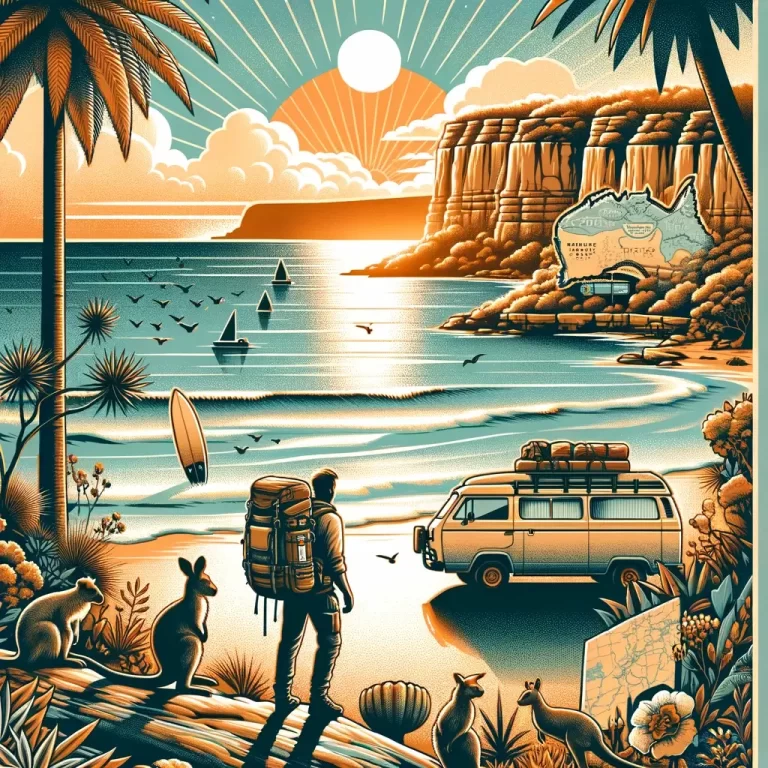Top National Parks Australia: Hidden Gems for Adventurers
Ever felt the thrill of discovering a hidden gem while traveling? That’s exactly what exploring Australia’s national parks feels like. Each park offers a unique adventure, from rugged outback landscapes to lush rainforests teeming with wildlife.
Australia’s top national parks aren’t just scenic wonders; they’re gateways to unforgettable experiences. Whether you’re hiking through ancient rock formations or snorkeling in vibrant coral reefs, there’s something for every adventurer looking to connect with nature and culture.
For those of us who crave unique travel experiences without being very costly, these parks also provide budget-friendly options that don’t skimp on awe-inspiring beauty. Plus, they often emphasize eco-friendly practices, making it easier to tread lightly while you explore.
I remember my first visit to Kakadu National Park—I was blown away by its sheer size and diversity. From Aboriginal rock art sites to cascading waterfalls, it felt like stepping into another world.
In this text, you’ll discover some of Australia’s must-visit national parks and get tips on how to make the most of your journey. Ready for an adventure? Let’s dive right in!
Want more travel inspiration across Australia? Check out our category of articles.
Exploring the Beauty of Australia’s National Parks
Australia’s national parks offer some of the most stunning landscapes and unforgettable experiences for adventurers. Here are a few must-visit parks that I highly recommend:
Kakadu National Park
Kakadu, located in the Northern Territory, spans nearly 7,700 square miles. It’s renowned for its diverse ecosystems, including wetlands, rivers, and sandstone escarpments. I found the ancient rock art at Ubirr incredibly captivating—it’s a glimpse into Indigenous culture dating back thousands of years.
Things to Do:
- Wildlife Spotting: See saltwater crocodiles in their natural habitat.
- Cultural Tours: Take guided tours led by Aboriginal people.
- Hiking Trails: Explore trails like the Barrk Sandstone Walk.
Daintree Rainforest
The Daintree Rainforest in Queensland is one of the oldest rainforests on Earth. Its biodiversity is unparalleled; you’ll find rare flora and fauna here. When I visited, walking across the Jindalba Boardwalk felt like stepping into another world.
Things to Do:
- Canopy Tours: Glide above treetops with zip-line adventures.
- Night Walks: Experience nocturnal wildlife on guided night walks.
- River Cruises: Spot unique creatures along the Daintree River.
Uluru-Kata Tjuta National Park
Uluru-Kata Tjuta in Central Australia is iconic for its massive red rock formations. The spiritual significance of Uluru to the local Anangu people adds depth to any visit. I enjoyed watching the colors change during sunrise and sunset—it’s truly magical.
Things to Do:
- Base Walks: Take a walk around Uluru’s base.
- Cultural Experiences: Join cultural tours to learn about Anangu traditions.
- Scenic Flights: Get aerial views of Uluru and Kata Tjuta.
Cradle Mountain-Lake St Clair National Park
Situated in Tasmania, this park features rugged mountains and serene lakes. Hiking routes like Overland Track attract adventure enthusiasts worldwide. During my hike, I saw wombats grazing freely—a sight I’ll never forget.
- Hiking Routes: Challenge yourself with multi-day hikes or shorter walks.
- Boat Tours: Navigate Lake St Clair’s pristine waters.
- Wildlife Viewing: Spot endemic species like Tasmanian devils and echidnas.

Top National Parks in Australia
Exploring Australia’s national parks offers a perfect blend of adventure travel, cultural immersion, and eco-tourism. Let’s jump into some must-visit parks that promise unique paths and unforgettable experiences.
Kakadu National Park, Northern Territory
Kakadu National Park is a UNESCO World Heritage site brimming with ancient rock art and abundant wildlife. I found the Ubirr Rock Art Site particularly fascinating; it’s like stepping back in time. For nature lovers, the Yellow Water Cruise provides an up-close look at saltwater crocodiles and diverse bird species. Budget-friendly tip: Visit during the dry season for more accessible trails.
Uluru-Kata Tjuta National Park, Northern Territory
Uluru-Kata Tjuta National Park is iconic for its massive sandstone monoliths. I joined a guided tour led by local Anangu people who shared captivating stories about their spiritual connection to Uluru. Sunrise and sunset are prime times for photography enthusiasts to capture the shifting colors of the world. Eco-friendly practice: Stick to marked trails to protect fragile ecosystems.
Royal National Park, New South Wales
Royal National Park is ideal for those seeking lush coastal walks and serene beaches. The Figure Eight Pools are a highlight but visit them only during low tide for safety reasons. I loved hiking the Coast Track; it offers breathtaking ocean views and opportunities for whale watching during migration seasons (May-November). Practical advice: Pack plenty of water as facilities can be sparse.
Daintree National Park, Queensland
Daintree Rainforest boasts rich biodiversity and stunning scenery. A canopy tour gave me a bird’s-eye view of this ancient rainforest teeming with life. Don’t miss Mossman Gorge where you can swim in crystal-clear waters surrounded by lush greenery—perfect for cooling off after trekking through jungle trails. Actionable tip: Use eco-friendly insect repellent to protect both yourself and the environment.
Famous Attractions in Australian National Parks
Australia’s national parks are teeming with unique wildlife, ancient cultural sites, and unforgettable landscapes. These attractions make them perfect for adventure travel and eco-tourism.
Unique Wildlife and Flora
Many parks host endemic species like the kangaroo, koala, and emu. In Kakadu National Park, I spotted saltwater crocodiles basking along the riverbanks. The Daintree Rainforest is home to the cassowary, an elusive bird that looks prehistoric.
Flora enthusiasts shouldn’t miss Kings Canyon in Watarrka National Park. It boasts vibrant rock gardens filled with cycads and ghost gum trees. For a splash of color, visit during the wildflower season in spring at Kalbarri National Park in Western Australia.
Historical and Cultural Sites
Australia’s national parks also offer rich cultural experiences. Uluru-Kata Tjuta National Park features ancient Aboriginal rock art dating back thousands of years. Guided tours can provide insights into the spiritual significance of these artworks.
In Royal National Park near Sydney, you can explore remnants of early European settlements while hiking coastal trails. Over in Tasmania’s Cradle Mountain-Lake St Clair National Park, I marveled at historical huts used by early explorers.
To fully immerse yourself in these experiences:
- Join guided tours: Many parks offer indigenous-led tours providing authentic cultural insights.
- Respect local customs: Ensure your actions align with eco-friendly practices.
- Capture moments responsibly: Use photography without disturbing wildlife or damaging flora.
Adventure Activities in National Parks
Exploring Australia’s national parks offers not just stunning landscapes but also a variety of adventure activities. For millennial adventurers like me, these parks provide the perfect backdrop for hiking, water sports, and more.
Hiking and Bushwalking Trails
Australia’s national parks feature numerous trails catering to all levels of hikers. In Royal National Park, I found the Coast Track particularly rewarding. Spanning 16 miles (26 km), this trail showcases coastal cliffs, secluded beaches, and lush rainforests.
In Cradle Mountain-Lake St Clair National Park, the Overland Track is an iconic multi-day hike stretching 40 miles (65 km). This trail takes you through diverse terrains including alpine meadows and ancient rainforests. If you’re short on time or prefer shorter hikes, Daintree Rainforest’s Mossman Gorge offers several loop trails that are equally captivating.
Pro Tips:
- Gear Up: Wear sturdy hiking boots and carry a lightweight backpack with essentials like water, snacks, sunscreen, and a first-aid kit.
- Plan Ahead: Check weather conditions and park regulations before heading out.
- Stay Eco-friendly: Stick to marked paths to minimize environmental impact.
Water Sports and Activities
National parks in Australia offer an array of water-based adventures suitable for every budget. At Kakadu National Park, canoeing along the East Alligator River allows you to spot saltwater crocodiles and vibrant birdlife up close.
For a mix of adventure and relaxation, snorkeling at Ningaloo Marine Park is unbeatable. Here I swam alongside whale sharks—an unforgettable experience! On calmer days, kayaking around Jervis Bay provides crystal-clear waters perfect for spotting dolphins.
- Safety First: Always wear life jackets while engaging in any water activity.
- Eco-conscious Practices: Use reef-safe sunscreen to protect marine life.
- Budget-Friendly Options: Consider renting equipment locally instead of bringing your gear.
By integrating these tips into your plans you’ll have a memorable adventure while respecting nature’s beauty!
Tips for Visiting National Parks in Australia
Australia’s national parks offer incredible adventures and cultural experiences. Here are some tips to make the most of your visit.
Best Times to Visit
Timing is crucial when planning a trip to Australia’s national parks. For example, Kakadu National Park is best visited in the dry season (May-October) when you can access all areas and enjoy lower humidity. The Daintree Rainforest sees fewer visitors from May to September, offering cooler temperatures ideal for hiking and exploring.
In contrast, Uluru-Kata Tjuta National Park provides stunning sunsets year-round, but the shoulder seasons (April-May, September-October) offer milder weather and fewer crowds. Cradle Mountain-Lake St Clair National Park shines brightest between December and February when Tasmania enjoys its summer highs.
| National Park | Best Time to Visit |
|---|---|
| Kakadu National Park | May – October |
| Daintree Rainforest | May – September |
| Uluru-Kata Tjuta National Park | April – May, Sep – Oct |
| Cradle Mountain-Lake St Clair NP | December – February |
Essential Items to Bring
Packing smart enhances your park experience while ensuring safety and comfort:
- Sun Protection: Sunscreen with high SPF, sunglasses, wide-brim hats.
- Hydration Gear: Reusable water bottles or hydration packs.
- Navigation Tools: Maps, GPS devices—cell service is often unreliable.
- First Aid Kit: Essentials like bandages, and antiseptics; useful for minor injuries.
- Eco-Friendly Bags: Reusable bags for waste; leave no trace principles matter.
- Comfortable Footwear: Hiking boots or sturdy shoes suitable for rough terrains.
- Weather-Appropriate Clothing: Layered clothing; nights can get chilly even in warmer climates.
- Photographic Equipment: Cameras with extra batteries/memory cards for capturing unique moments.
For instance, during my hike through the Overland Track in Cradle Mountain-Lake St Clair NP, having layered clothing was essential due to Tasmania’s unpredictable weather patterns.
To make budgeting easier without missing out on key items, consider using a packing guide that aligns with these essentials.
Remembering these tips ensures a more enjoyable adventure while respecting nature’s beauty and fragility.
Don’t forget to check local guidelines before visiting any national parks as conditions may change based on environmental factors or park regulations.
Key Takeaways
- Diverse Landscapes and Wildlife: Australia’s national parks offer a variety of stunning landscapes from rugged outback terrains to lush rainforests, providing habitats for unique wildlife such as kangaroos, koalas, and saltwater crocodiles.
- Cultural Immersion: Many parks feature significant Indigenous cultural sites, like the rock art in Kakadu National Park and Uluru’s sacred monoliths. Guided tours often provide deeper insights into Aboriginal history and traditions.
- Adventure Activities: Visitors can enjoy a range of activities including hiking on iconic trails like the Overland Track in Cradle Mountain-Lake St Clair NP, snorkeling in Ningaloo Marine Park, and zip-lining through the Daintree Rainforest.
- Eco-Friendly Travel: Australia’s national parks emphasize sustainable practices. Travelers are encouraged to follow eco-friendly guidelines such as sticking to marked paths, using reef-safe sunscreen, and participating in guided tours that support local communities.
- Budget-Friendly Options: Many national parks provide affordable travel experiences without skimping on natural beauty. Visiting during off-peak seasons or opting for budget accommodations can make these adventures more accessible.
- Essential Tips for Visiting: Plan your visit according to the best times of year for each park, pack essential items like sun protection and hydration gear, and always check local guidelines to ensure a safe and enjoyable experience.
Frequently Asked Questions
What are some must-visit national parks in Australia?
Australia boasts many stunning national parks, including Kakadu National Park, Daintree Rainforest, Uluru-Kata Tjuta National Park, and Cradle Mountain-Lake St Clair National Park. Each offers unique landscapes and experiences.
What activities can I do in Australian national parks?
Visitors can enjoy a range of activities such as wildlife spotting, cultural tours, hiking, canoeing, and snorkeling. Specific trails like the Coast Track in Royal National Park and the Overland Track in Cradle Mountain-Lake St Clair National Park are popular for hikers.
When is the best time to visit Australian national parks?
The best time to visit varies by park. Generally, spring (September to November) and autumn (March to May) offer mild weather and fewer crowds. Always check specific conditions for each park before planning your trip.
What should I bring when visiting a national park?
Essential items include plenty of water, snacks, sun protection (hat, sunscreen), sturdy walking shoes, a first aid kit, insect repellent, a map or GPS device, and appropriate clothing for weather conditions.
Are there any safety tips for hiking in Australian national parks?
Safety tips include staying on marked trails, informing someone about your plans before you go hiking, carrying sufficient food and water supplies, wearing suitable footwear and clothing, checking weather forecasts beforehand, and following all local guidelines.
Can you recommend any water sports activities in Australian national parks?
Yes! Popular water sports include canoeing in Kakadu National Park and snorkeling at Ningaloo Marine Park. These activities allow visitors to explore Australia’s diverse aquatic ecosystems while enjoying an adventurous experience.
How can I practice eco-friendly tourism while visiting these parks?
To practice eco-friendly tourism: Leave no trace by taking all trash with you; stay on designated paths; avoid disturbing wildlife; use biodegradable products; conserve water; support conservation efforts by respecting rules set by park authorities.







